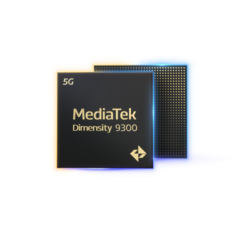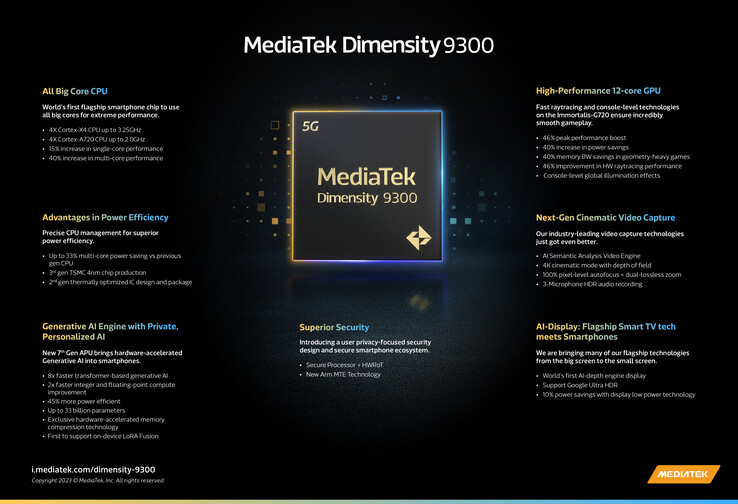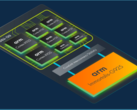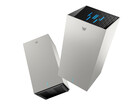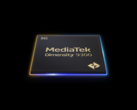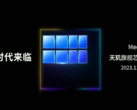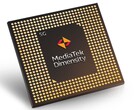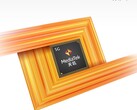After Apple's M3 lineup and Qualcomm's Snapdragon 8 Gen 3 and X Elite SoCs, it is now time for MediaTek's Dimensity 9300 to hog the limelight. The Dimensity 9300 sports 22.7 billion transistors and is fabbed on the TSMC's third gen 4 nm+ process.
Dimensity 9300 sans efficiency cores
We've been hearing about the MediaTek Dimensity 9300 for quite some time now. Both the Snapdragon 8 Gen 3 and the Dimensity 9300 rely on the ARM v9.2 design, which was unveiled during Computex 2023. However, the 8 Gen 3 implements a 1+5+2 (X4+A720+A520) design. The Dimensity 9300, on the other hand, uses a quad-Cortex-X4 and quad-Cortex-A720 arrangement with no efficiency cores.
Not all four Cortex-X4 cores are prime cores, though. One Cortex-X4 is clocked at 3.25 GHz while the remaining three make do with 2.85 GHz. The quad-Cortex-A720 cores are all clocked at 2 GHz.
MediaTek claims that this should result in a 15% higher single-core and 40% higher multi-core performance compared to the Dimensity 9200. However, the power at which such high gains are achieved is still unclear. MediaTek itself refers to this 40% uplift as "peak performance", which should raise some eyebrows.
The company also said that the Dimensity 9300 can achieve a similar performance as the Dimensity 9200 at 33% lower power.
MediaTek's logic is that instead of using efficiency cores for low-power tasks, the performance cores can take over, finish the task faster, and clock down to idle. Given ARM's claims of 40% improved power efficiency with the Cortex-X4, it might actually make sense to ditch those efficiency cores after all. We will know the real-life implications once we get to test Dimensity 9300-powered devices in the coming months.
Based on leaks so far, the Dimensity 9300 already amasses a Geekbench 6.1 multi-core score around the 7,110 mark and single-core score of about 2,244. This makes for an interesting comparison with the Snapdragon 8 Gen 3 reference design scores (2,329 single and 7,501 multi; Geekbench 6.2). We should see better numbers as we near closer to release.
The Dimensity 9300 also features an 8 MB L3 cache along with a 10 MB system cache, support for LPDDR5T-9600 memory, and UFS 4 with multi-circular queue (MCQ). MCQ allows each CPU core to handle data transfer simultaneously.
Console-level global illumination with Immortalis-G720 12-core GPU
During its Computex 2023 keynote, ARM also spoke at length about the Immortalis-G720 GPU based on the new 5th Gen architecture. The Immortalis-G720 can be configured with 10 cores or more, and MediaTek has opted for a 12-core offering.
ARM did say back then that it has been working with Tencent and MediaTek on the Smart Global Illumination (SmartGI) tech for ray tracing. Accordingly, MediaTek claims that the Dimensity 9300 is capable of producing console-level GI.
Other performance and efficiency claims are more or less in-line with ARM's specifications for the Immortalis-G720. These include a purported 46% higher performance with a 40% higher power efficiency and a 46% gain in hardware-accelerated ray tracing performance.
APU 790 for on-device generative AI
On-device generative AI is quite the buzzword these days, especially given all the hype that the Pixel 8's Tensor G3 generated but didn't seem to quite live up to. MediaTek, on its part, is claiming some profound numbers about the Dimensity 9300's APU 790.
According to the company, the APU is capable of some serious number crunching while being 45% more efficient. The APU 790 is supposedly capable of processing a 7-billion parameter LLM at 20 tokens per second. With 16 GB of RAM, the APU can accommodate a 13-billion parameter LLM and this can go up to 33 billion parameters with 24 GB RAM at the expense of lower token rate.
Other features include:
- Support for 180 Hz WQHD or 120 Hz 4K panels
- Support for Google Ultra HDR
- Always-on HDR capture in 4K cinematic mode with depth of field
- Dedicated OIS sensor core
- Full pixel-level autofocus and dual-lossless zoom
- 5G speeds up to 7 Gbps downlink
- Wi-Fi 7
- Dedicated secure processor
- ARM's memory tagging extension (MTE)
Availability: Europe and Asia-only for now
Availability has always been a hit-or-miss with Dimensity SoCs. For instance, we could test only the OnePlus Pad, Nord 3, and Lenovo Tab Extreme featuring the Dimensity 9000, a couple of Asus ROG Phone 6Ds featuring the Dimensity 9000+, and the lone Vivo X90 Pro that uses the Dimensity 9200.
According to MediaTek, the Dimensity 9300 soft launches in China today. Information pertaining to global markets will be made available shortly. The chip maker is primarily targeting Europe and Asian markets such as China for now with no word on US availability.
Source(s)
MediaTek Press Release




